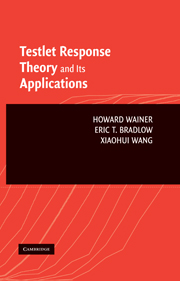Book contents
- Frontmatter
- Contents
- Preface
- PART I INTRODUCTION TO TESTLETS
- PART II BAYESIAN TESTLET RESPONSE THEORY
- 7 A brief history and the basic ideas of modern testlet response theory
- 8 The 2-PL Bayesian testlet model
- 9 The 3-PL Bayesian testlet model
- 10 A Bayesian testlet model for a mixture of binary and polytomous data
- 11 A Bayesian testlet model with covariates
- 12 Testlet nonresponse theory: dealing with missing data
- PART III TWO APPLICATIONS AND A TUTORIAL
- Glossary of terms
- Epilogue
- Bibliography
- Author Index
- Subject Index
8 - The 2-PL Bayesian testlet model
Published online by Cambridge University Press: 08 January 2010
- Frontmatter
- Contents
- Preface
- PART I INTRODUCTION TO TESTLETS
- PART II BAYESIAN TESTLET RESPONSE THEORY
- 7 A brief history and the basic ideas of modern testlet response theory
- 8 The 2-PL Bayesian testlet model
- 9 The 3-PL Bayesian testlet model
- 10 A Bayesian testlet model for a mixture of binary and polytomous data
- 11 A Bayesian testlet model with covariates
- 12 Testlet nonresponse theory: dealing with missing data
- PART III TWO APPLICATIONS AND A TUTORIAL
- Glossary of terms
- Epilogue
- Bibliography
- Author Index
- Subject Index
Summary
Introduction
As described in the preceding chapters, the initial goal of testlet response theory (TRT) was to generalize existing item response theory (IRT) models so that in the case where no testlet dependence occurred, the model would specialize to the standard atomistic testing setting in which the assumption of conditional independence across items is commonly assumed and likely to hold. However, in those cases where multiple items are based upon a single stimulus (passage, table, etc. …), and extra dependence across items does exist, the model is able to naturally account for this. A major advantage of this approach is that it allows us to use the familiar nomenclature of IRT, and thus aids in easy interpretation of the results, as users are familiar with the model, except for the addition of a “testlet term.” In addition, standard and widely distributed programs such as MULTILOG 7 (Thissen Chen, & Bock, n.d.) could be used as both a validation check for our inferences as well as providing starting values for our procedures.
The model specification
In this vein, the initial TRT model developed in Bradlow, Wainer, and Wang (1999) had the following characteristics and serves as an important baseline model (which has subsequently been extended and described in Chapters 9–11). We first begin by describing the characteristics of the model, followed by computation under the model, a demonstration of the efficacy of the model, and finally extensions to this baseline model.
Information
- Type
- Chapter
- Information
- Testlet Response Theory and Its Applications , pp. 118 - 133Publisher: Cambridge University PressPrint publication year: 2007
